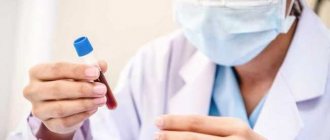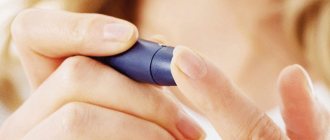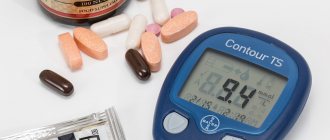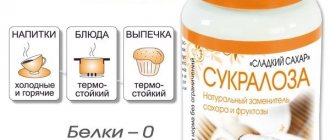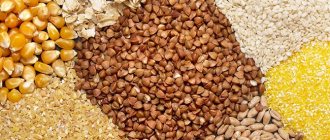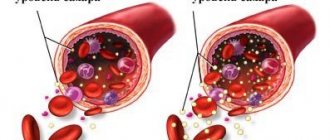Phytotherapy
Diabetes mellitus is divided into several types:
- insulin dependent (type 1):
- non-insulin dependent (type 2);
- gestational – manifests itself in pregnant women;
- prediabetes.
Each of them has its own causes, symptoms and methods of treatment. Traditional medicine suggests using herbs for diabetes to normalize glucose levels. However, herbal medicine is used only with the permission of an endocrinologist.
Self-medication can lead to deterioration of the condition, changes in hormonal levels, and in pregnant women - to premature birth.
The use of herbs has the following effects:
- Reduces sugar levels.
- Improves the excretion of glucose by the kidneys.
- Activates the liver and intestines.
- Improves sleep and well-being.
- Increases immunity.
Herbs will not cure diabetes, but they will reduce the likelihood of complications and improve overall well-being.
Side effects
Treatment with beneficial plants causes side effects. Medicines do not have as negative an effect on the body as medications. However, continued use is not recommended.
Burdock has negative effects when combined with diuretic drugs. Causes severe diarrhea.
Others can lead to nausea, headaches and dizziness. Such symptoms are also characteristic of an overdose of plants.
Medicinal plants
Herbal medicine is widely used to treat many diseases. List of herbs for type 2 diabetes:
- Chinese Schisandra, Eleutherococcus. These plants improve the body's ability to resist external influences.
- Diuretics – lingonberry leaf, birch, horsetail.
- Plants that produce insulin are burdock, licorice, blueberries.
- Containing chromium - fir, ginger, sage. They enhance the action of insulin, which leads to an improvement in the patient's condition.
- Corn silk and sage contain zinc, which stimulates wound healing and has an anti-infective effect.
- Dandelion, chicory and Jerusalem artichoke contain inulin, or a sugar substitute.
Traditional healers recommend using herbal teas for the treatment and prevention of diabetes. This makes it possible to saturate the body with microelements necessary to fight the disease.
What herbs lower blood sugar levels?
Wise nature has created plants that are capable of performing the function of insulin.
These plants mildly regulate blood sugar levels. In the case of prediabetes, when sugar levels are at the upper limit of normal values and in mild forms of type 2 diabetes, various herbal decoctions and infusions are used as additional therapy. The use of these medicinal preparations is possible only after consultation with a doctor, and herbs in no case can replace medications.
The best herbs that contain insulin-like substances and lower blood sugar levels include:
- Bay leaf;
- Ginseng;
- Rhodiola rosea;
- Horsetail;
- Astragalus;
- Nettle;
- Cottonweed;
- Dandelion leaves;
- Flax seeds.
Endocrinologists recommend making collections from these plants that would contain no more than 5 medicinal plants. To obtain a decoction, you need to take 15 grams of herbs in equal proportions and brew 200 ml of boiling water. Take at regular intervals throughout the day, and it is important to monitor your condition, since such preparations can enhance the effect of medications. More than 3 hundred plants used in folk medicine grow in Russia, one third of them have properties beneficial for diabetics. Scientists have not fully studied the mechanism of action of these herbal preparations, but the principle of action of sugar-lowering herbs is known:
- Slows down the process of carbohydrate absorption;
- Affects the process of glycogen formation in the liver;
- Has no toxic effect;
- Do not accumulate in the body.
These herbs can be drunk either individually or combined in various proportions. The most effective method is a course of taking each medicinal plant for no more than 4 weeks.
Contraindications
For diseases such as diabetes, plants must be used with caution. The use of herbs is contraindicated in the following situations:
- Individual intolerance to herbal preparations.
- Allergic reactions.
- Blood sugar is unstable.
- Any complications associated with the disease.
During pregnancy and breastfeeding, it is important for women to consult a doctor. The use of herbs can cause premature birth and worsening of the condition.
Bay leaf
Medicinal herbs for diabetes are aimed at normalizing glucose levels and enhancing the action of insulin. Bay leaves contain useful substances that help strengthen human immunity and normalize metabolism in the body.
The course of taking any decoction should not exceed 3 weeks. Be sure to take breaks so as not to harm the body. While taking bay leaf, you need to measure your sugar daily with a glucometer.
How to prepare a medicinal decoction:
- 10 leaves are washed with water, poured boiling water, covered with a lid and allowed to brew for three hours. Take 100 ml of the product 30 minutes before meals.
- A dozen bay leaves are poured with 300 ml of clean water. Place on the stove and boil for several minutes. Then the broth is poured into a thermos and left for 4 hours. Drink this infusion, strained, throughout the day.
It is forbidden to use bay leaves in severe diabetes, individual intolerance, kidney, liver and heart diseases. Take the decoction with caution during pregnancy and lactation.
Herbs for type 2 diabetes
Endocrinologist M.V. Saydak
Medicinal plants have been used to treat many diseases since ancient times, and diabetes is no exception. For the treatment of pathology, herbs that contain insulin-like compounds are used.
In addition, restorative, vitamin-containing and other plants are popular. Herbs for type 2 diabetes cannot replace full-fledged drug treatment, but with their help they can improve health and normalize the patient’s overall well-being.
What are herbs used for?
Type 2 diabetes mellitus is an endocrine disease that is caused by impaired glucose tolerance. The pancreas produces the vital hormone insulin in sufficient quantities, but it cannot break down sugar, since tissue susceptibility to glucose is impaired. To achieve normoglycemia, that is, normal glucose levels, sugar-lowering medications, a special diet and exercise are used. Herbs for type 2 diabetes also have the ability to reduce blood glucose levels, saturate the body with vitamins, and restore immunity.
Goals of herbal medicine:
- normalization of glucose levels in blood and urine. Thanks to the natural insulin-like components contained in some plants, with regular use of herbs it is possible to reduce the dose of sugar-lowering drugs, and sometimes even partially replace them;
- removing excess glucose from the body naturally;
- prevention of such consequences of diabetes as damage to the eyes, liver, kidneys, blood vessels, skin;
- restoration of the functioning of the pancreas;
- strengthening general health, increasing immunity;
- improvement of psychological well-being, normalization of sleep.
We must not forget that medicinal plants are used exclusively as an auxiliary therapy. Herbs only complement the treatment prescribed to the patient by the doctor. Refusal of basic therapy can provoke life-threatening and health-threatening consequences.
Rules for treatment using herbal medicine
Before starting herbal therapy, each patient should consider some features of herbal medicine. Following simple rules will help you achieve the best effect, eliminate negative complications and deteriorate your overall health.
Recommendations for the use of herbs for diabetes:
- any plant or herbal mixture must be approved by the attending physician or herbalist, who takes into account the form of diabetes, the individual characteristics of the human body and some other aspects;
- treatment with herbs should be carried out in courses; interrupting therapy is not recommended; a good effect can only be achieved with regular use of natural medicines;
- before a course of therapy, it is necessary to carefully study the composition and contraindications of herbs;
- if even minor side effects occur, treatment should be discontinued immediately;
- When buying herbs in pharmacies or stores, you must definitely pay attention to the expiration date of the herbal medicine, and do not hesitate to ask for a license to sell medicinal plants.
When independently procuring raw materials, it is recommended to collect herbs in places far from roads, factories, and animal pastures. It is better to give preference to environmentally friendly places - forests, clearings, river banks. You cannot buy plants at the market, because when buying herbs from hand, there is no confidence in the quality of the products. In addition, when preparing medicinal material, it should be taken into account that many plants are very similar to each other.
Important! Many natural plants cause allergies. If rashes, skin itching or other alarming symptoms appear, it is recommended to stop treatment and consult a doctor.
What herbs are used for type 2 diabetes
What herbs do experts recommend using for type 2 diabetes? The type of plants is selected depending on the treatment objectives. For illness, the following herbs are used:
- vitamin-containing. These plants are prescribed to patients to saturate the body with beneficial vitamins and minerals. Among them, nettles, rose hips, lingonberry leaves and others are popular;
- restoring metabolism. Since type 2 diabetes is directly related to metabolic disorders in tissues, the use of plants that enhance metabolic processes in the disease is necessary. Herbs such as plantain, lemon balm, dandelion, fireweed, yarrow and others cope well with this task;
- restorative. Calamus, chicory, ginseng, hibiscus, fragrant rue and others are used here;
- sugar-lowering. The group of sugar-lowering plants includes burdock root, clover leaves, elecampane, blueberry leaves, mantle, redberry and others.
I use herbs both individually and in the form of medicinal mixtures. Some plants have a combined effect. For example, strawberry leaves brewed as tea, in addition to reducing sugar, have an anti-inflammatory and strengthening effect. Nettle helps saturate the body with vitamins, has a mild diuretic effect, and increases hemoglobin.
Contraindications to herbal medicine
Despite the apparent safety, in some cases, herbal treatment is strictly contraindicated. It is prohibited to use herbal medicine in patients under the following circumstances:
- tendency to allergies;
- severe diabetes and its life-threatening complications - hypoglycemic, hyperglycemic coma and other conditions;
- frequent increase or decrease in blood glucose concentration.
Treatment of type 2 diabetes mellitus with the help of medicinal plants is carried out during the period of remission of the pathology, when blood and urine sugar levels are stable. Therapy is carried out in strict accordance with the doctor’s recommendations. It is not recommended to select plants yourself.
Sugar-lowering herbs
Sugar-lowering herbs are included in many pharmaceutical drugs used for type 2 diabetes. These plants are rich in insulin-like components that regulate blood glucose levels. So, what herbs should patients with non-insulin-dependent diabetes drink?
Burdock root
Burdock contains essential and fatty oils, bitter glycosides, tannins, polysaccharide inulin, vitamins and minerals. To treat the disease, herbalists recommend patients drink a decoction prepared from the roots of the plant.
Cooking method:
- Grind the dry leaves and roots of the plant, place a tablespoon of raw materials in an enamel bowl.
- Pour a glass of boiling water over the product and simmer in a water bath for about 25 minutes.
- Cool the finished broth and strain through a cloth or fine sieve.
The medicine is stored in the refrigerator. You need to take the drink one tablespoon three times a day before meals. The course of therapy is 30 days.
Clover leaves
The leaves of this plant contain carotene, phytoestrogens, flavonoids, tannins, proteins, fats, organic acids, and many vitamins and minerals. The fact that clover helps normalize glucose concentrations in the body is scientifically proven.
Cooking method:
- To boil water.
- Add a teaspoon of crushed clover leaves to a glass of slightly cooled water and mix thoroughly.
- Infuse the drug for half an hour.
After this, strain the drink, take 2 tablespoons before each meal. The course of therapy should be at least one month.
Important! When treating with clover, it is necessary to strictly adhere to the dosage of the medicine, since exceeding the dose can lead to hypoglycemia. blueberry leaves
Blueberry fruits and leaves contain a huge number of components that can have a positive effect on the entire body. These include succinic, malic, acetic acid, beta-carotene, vitamins, and essential oils. For diabetes, the plant helps improve the functioning of the pancreas, saturate the body with vitamins, and restore normal glucose levels.
Cooking method:
- Add a tablespoon of crushed dry leaves of the plant to 500 ml of boiling water.
- Simmer the medicine in a steam or water bath for at least half an hour.
- After this, remove the broth from the heat and let it brew well.
Take the drink, regardless of meals, 50 ml 4 to 5 times throughout the day. The duration of treatment is 30 days.
Elecampane
To stimulate the pancreas and reduce the concentration of sugar in the body, patients suffering from type 2 diabetes are prescribed the use of decoctions based on elecampane root.
Method for preparing the decoction:
- A tablespoon of peeled and crushed roots should be poured with half a liter of boiling water.
- Simmer the product in a steam bath for about an hour.
- Cool the finished broth and strain through a fine sieve or cloth.
You need to take half a glass of the drink before eating twice a day.
Method for preparing the tincture:
- A liter of alcohol or regular vodka should be mixed with 50 g of dry elecampane roots.
- Keep the tincture in a dark room with a cool temperature for at least 8 – 10 days. It is recommended to shake the medicine periodically.
- After preparation, the medicine is filtered and stored in the refrigerator.
The resulting product is consumed 20 drops three times a day. The product has no serious contraindications, except for personal intolerance to the components of the plant.
Herbs to restore metabolic processes
To restore metabolic processes, diabetics are recommended to use herbs that have the ability to improve metabolism in the body.
Plantain
Even children know about the beneficial properties of plantain. In addition to the ability to improve metabolism, the plant has an anti-inflammatory, wound-healing, and restorative effect. These properties help fight skin diseases that often develop with diabetes. Plantain juice has a beneficial effect on the digestive system and other organs.
Method for preparing the tincture:
- Add a few tablespoons of dry herb to half a liter of water.
- Cover the product with a lid and simmer in a water bath for approximately 30 - 40 minutes.
Leave the medicine to cool at room temperature, then strain. Take 100 ml infusion three times a day after meals.
In addition, you can use freshly squeezed plantain juice. It is especially useful in complex cases of the disease. To alleviate the condition, you need to drink a spoonful of juice three times a day. The course of treatment is 2 weeks.
Melissa
The lemon balm plant has long been studied by herbalists and attracts attention with its rich chemical composition. Its leaves contain resins, tannins, essential oils, iron, calcium and many other useful components. For diabetes, doctors recommend brewing tea based on lemon balm leaves. This drink enhances the body’s metabolism, promotes the renewal of lymphocytes and red blood cells. In addition, the herb normalizes blood pressure and has a positive effect on digestive processes.
Melissa helps improve the body's metabolic processes
Cooking method:
- Place several sprigs of herbs in a brewing container or thermos.
- Pour half a liter of boiling water over the raw material.
- Let the tea steep for at least an hour.
You can take the drink at any time of the day. The course of treatment is 1 month. After this, you should take a break of 2–3 weeks and repeat the therapy.
Dandelion
Sunflowers have been used to combat many ailments since ancient times. The plant contains many vitamins, minerals, iron, phosphorus, iodine, calcium, and alkaloids. The leaves of the herb contain inulin, which is used in pharmaceuticals to produce a sweetener.
There are several ways to treat diabetes using dandelion. Among them, the following are popular:
- fresh stems of the plant need to be washed and chewed, swallowing the secreted juice;
- Dandelion tea – prepared from flowers and grass stems. To do this, pour half a liter of boiling water over a spoonful of the product, leave the drink for half an hour, strain, and take warm;
- tincture. To prepare an alcohol tincture, place dandelions along with flowers in a glass container and pour in alcohol in a ratio of one part flowers to two parts alcohol. The product is infused for 21 days, then filtered, and taken 10 drops three times a day for a month.
Important! Medicines containing dandelions should not be used by patients suffering from digestive diseases or individual intolerance to the components of the plant.
General strengthening and vitamin-containing plants
Vitamin-containing herbs help saturate the body with essential vitamins and minerals, strengthen the immune system, improve emotional well-being, and normalize the functioning of all internal organs and systems.
Lingonberry leaves
The leaves and berries of the plant contain vitamins A, B, C and E, carbohydrates and carotene, tannins, phosphorus, magnesium, potassium, and organic acids. In addition to its vitaminizing and immunostimulating effect, lingonberries perfectly relieve inflammation, have a bactericidal effect, and restore pancreatic cells.
Lingonberries for diabetes improve immunity and saturate the body with vitamins
Cooking method:
- Chop fresh or dry lingonberry leaves.
- Place a few tablespoons of raw materials in an enamel bowl and pour half a liter of boiling water.
- Simmer the broth over low heat for 20 minutes.
Take the medicine in the form of tea in between meals. A strengthening drink can be prepared using only leaves or with the addition of dry or fresh berries.
Ginseng root
Ginseng is used for all forms and stages of diabetes. The plant is contraindicated in cases of severe nervous excitability, neuralgic disorders, tachycardia and arterial hypertension.
Method of use:
- Wash the root of the plant and dry well.
- Grind the rhizome thoroughly until a powder forms.
- Pour a few tablespoons of the product with half a liter of alcohol or vodka.
- Keep the tincture in a dark room for 30 days, shaking the product periodically.
You need to take the medicine 10 drops, diluting them with water three times a day for a month.
Medicinal herbs for type 2 diabetes mellitus are an excellent addition to the main treatment of the disease. Proper use of natural remedies provides a lasting effect, rarely causes side effects, and helps prevent pathological complications. Compliance with the dosage and time of taking herbal medicines and following the doctor’s recommendations is the key to successful treatment of diabetes.
Plantain
For diabetes mellitus, herbs improve the functioning of the thyroid gland. Plantain decoction is used to treat many diseases and improves well-being. How to prepare it:
- Plantain leaves are poured with boiling water in a small container and covered with a lid.
- Place the container in a water bath and keep for at least 30 minutes.
- The cooled broth is filtered.
For the best effect, it is recommended to drink 150 ml of plantain infusions before meals. This decoction can also be used to heal wounds.
Plantain seed is also used to prepare the tincture. Making a decoction:
- Plantain seeds – 1 tsp. pour into a saucepan and add hot water, boil for 5 minutes.
- After the broth has cooled, strain through cheesecloth.
It is recommended to take an infusion of plantain seeds, 3 tsp. daily, but not more than 30 days in a row.
When choosing herbs for diabetes, it is important to study their beneficial properties and become familiar with contraindications.
Galega
Specialists in the field of traditional medicine pay special attention to such a plant as goat's rue. The herb galega for diabetes can not only normalize glucose levels, but also cure the initial stage.
How to take it correctly:
- To prepare the infusion, pour boiling water over a teaspoon of the dried plant. Leave for at least 2 hours. Drink the strained broth 3 times a day in equal parts.
- The second method allows you to significantly reduce your sugar levels. To do this, pour boiling water over 2 teaspoons of the dry plant and leave it covered for 12 hours. Drink 100 ml three times a day after meals.
- Herbs for diabetes should only be taken in the form of infusions. Galega seeds are used to treat the disease at an early stage. To do this, they are poured with cold water and boiled for at least 5 minutes over low heat, and then allowed to stand for 2 hours. Drink this decoction 30 minutes before meals, 20 ml.
It is important to remember that the herb galega has diuretic properties.
Bean pods
Herbs for type 2 diabetes are widely used in folk medicine. Natural remedies cause virtually no side effects and are highly effective.
Bean leaves improve metabolism in the body and also participate in the processing of proteins. In addition, they form hormones that are necessary for the treatment of diabetes.
How to prepare the decoction:
- Dried bean pods are poured with boiling water and left covered for a day.
- Use medicinal decoction 3 times a day before meals, 150 ml.
You can make tea from bean leaves:
- Fresh pods are finely chopped and poured with boiling water.
- Boil the tea over low heat.
- Let it brew.
- After the drink has cooled, it is filtered.
- You need to drink this tea 3 times a day in small portions.
We must not forget about contraindications, such as:
- Individual intolerance.
- Allergic reactions to legumes.
- Asthma.
- Pregnancy.
A decoction of bean leaves will improve well-being and enhance the effect of insulin taken by the patient.
Stevia sweetener
As a rule, patients with diabetes are forced to give up sugar. It turns out that a plant similar to mint can completely replace it. Stevia and sweeteners based on it can replace sweets.
Stevia is a safe natural sweetener. It is useful because:
- Relieves fatigue, energizes;
- Works as a prebiotic, improving digestion, reducing appetite;
- Strengthens the walls of blood vessels, protects against atherosclerosis, heart attack and stroke;
- Reduces blood pressure;
- Helps restore the gastric mucosa.
Stevia has high sweetness and minimal calorie content. As a rule, it is available in powders, tablets, drops, and tea bags. To sweeten the tea, just drop 7-8 drops of extract or add powder on the tip of a knife.
Anyone who wants to lose weight, but cannot live without sweets, can easily put it in tea or coffee. In addition, stevia powder can be added to baked goods, preserves, and jams. For example, in the departments for diabetics with stevia you can buy halva, marshmallows, and other desserts.
Burdock
The leaves of this plant have antioxidant properties, which allows it to be used for type 2 diabetes. Herbs show high effectiveness in combating the disease.
Experts note that the chemical composition of burdock root can influence symptoms such as increased thirst and wound healing. It increases performance and reduces appetite.
How to prepare a healing decoction of burdock:
- A tablespoon of dried roots is crushed and poured into 0.5 liters of boiling water.
- Cook over low heat for about 20 minutes.
- The broth is filtered and cooled.
- Take the medicine three times a day, 30 minutes before meals, 1 dessert spoon.
The course of treatment with burdock decoction is at least 30 days.
When prerequisites for the development of diabetes appear, experts recommend making a herbal mixture: blueberry leaves, burdock root, bean leaves and flax seeds. Boil everything together over a fire, filter and take before meals.
How do medicinal herbs help?
Healing plants have been used for hundreds of years to treat many diseases, including diabetes. Diabetes supplements do not help to completely get rid of the disease, but they can be an excellent support for the human body, reduce sugar, and improve overall well-being.
Roughly speaking, for people suffering from diabetes, all medicinal plants can be divided into two categories: herbs that reduce sugar and “other” plants.
The first category of plants helps reduce the concentration of glucose in the body, since they contain insulin-like components. The second category consists of plants that provide regulation of metabolic processes in the body and help restore the functionality of the liver, kidneys and other internal organs.
Generally speaking, treatment with folk remedies is as follows:
- For type 2 diabetes, the patient takes medications, plus exercises and eats right. If the form of diabetes is severe, then you may be taking medications.
- In the first type of disease, the patient drinks decoctions based on the necessary plants, injects insulin, and follows other doctor’s recommendations.
Despite the fact that herbs can be taken to support the body against the background of type 1 diabetes, medical practice shows that they really are of “little use.” Since, no matter what “magic” plant it is, there is no escape from insulin, and it is unlikely to be possible to reduce its dosage.
However, for type 1 diabetes, plants classified as “other” can be used.
As mentioned above, herbs must be purchased at a pharmacy. But you can also collect it yourself, provided that the collection is carried out in an environmentally friendly place and the person has the appropriate knowledge.
Elecampane
For treatment, use young grass that is no more than a year old. It retains all the beneficial properties. They use elecampane root, which is cut into small pieces and dried in the sun.
A decoction from the plant improves metabolism and normalizes the absorption of protein in the body. In addition, it has a beneficial effect on intestinal function. It should not be used during pregnancy, as it can cause uterine contractions and lead to premature birth.
To prepare a decoction of elecampane, take a teaspoon of finely chopped roots of the plant and pour boiling water over it. The infusion is placed on the stove and cooked for 15-20 minutes over low heat, then left to infuse under a towel. It should acquire a rich shade. The strained broth is taken 5-7 tablespoons throughout the day.
St. John's wort
The healing herb is considered the most effective for treating many diseases. In folk medicine, inflorescences are used, which are collected at the very beginning of flowering, when the plant is gaining strength.
St. John's wort is used to treat diabetes, as well as heart disease, during a flu epidemic, for headaches and insomnia. St. John's wort can improve mood and help cope with depression.
How to prepare the infusion:
- Dried flowers must first be crushed a little, then pour boiling water over them.
- Infuse the herbal decoction for 4 hours in a dark place.
- Apply 20 ml before meals.
How to prepare butter:
- St. John's wort flowers are poured with olive oil in a 1:1 ratio and infused for at least 3 weeks.
How to brew tea:
- Place 1 teaspoon of St. John's wort flowers into a teapot, pour boiling water over it and let it brew.
- You can add honey and fresh berries to tea.
St. John's wort products should not be used for more than 30 days in a row. Completely avoid the use of decoction and tea during pregnancy and lactation.
Bearberry
Both leaves and shoots of the plant are used in treatment. Bearberry has antiseptic properties. How to prepare an infusion from the plant:
- Pour 2 tablespoons of dried leaves into a glass of boiling water and leave for 24 hours.
- The strained broth is taken in a glass 3 times a day.
We must not forget that most plants have a diuretic effect. It is forbidden to use herbal decoctions for kidney problems.
In case of diabetes mellitus, special attention is paid to health. Before using decoctions of herbs and plants, consultation with your doctor is required to avoid side effects and worsening the condition.
Kvass according to Bolotov's recipes
Bolotov's herbal kvass help in the treatment of the “sweet disease”. Here are the beneficial properties of kvass:
- During fermentation in kvass, useful enzymes are formed that have a beneficial effect on the functioning of the gastrointestinal tract, and especially the pancreas.
- Suppresses the activity of dangerous microbes;
- Improves metabolism and function of the endocrine system;
- Strengthens nerves, and at the same time hair, nails, improves the quality of the skin;
- Helps normalize the functioning of the cardiovascular system;
- Increases immunity, infuses energy, removes decay products from the body.
In addition, thanks to special enzymes, kvass treats:
- myopia,
- glaucoma,
- retinal detachment,
- bronchitis,
- lung diseases.
Below you will find popular and effective kvass recipes in accordance with Bolotov’s recommendations.
Beetroot-blueberry kvass
First you need to grate the beets, and puree the blueberries and mix.
- In a 3-liter jar put 4 tbsp. spoons of the mixture, add the juice of half a lemon, 1 tbsp. sour cream, 1 teaspoon honey.
- Then pour in 2 liters of boiled water.
- After this, after 1 hour, you can drink 100 ml of kvass per day.
This amount is enough for a week. Must be stored in the refrigerator. As a rule, constant intake of this kvass reduces the sugar level to normal, that is, to 5.5 mmol.
Bread kvass
Place dried slices of rye bread in a saucepan, then add lemon balm, mint and pour in boiling water. Then the container should be wrapped in a blanket and placed in a warm place for 24 hours.
After a day, strain, add 1 teaspoon of honey, crushed peas, flour and yeast. Then leave to ferment for 7 hours.
Then strain, pour into bottles, add 5 raisins to each. After this, cover and transfer to the refrigerator. Store for a week. During this time you need to drink 100 ml several times a day.
Recipe for making oat kvass
- Pour 200 g of oats along with the husks into a 3-liter jar. Fill with water, but not to the very top.
- Then you need to add 4 tbsp. l. granulated sugar, or 2 tbsp. spoons of honey, put 7-8 raisins.
- Cover and store in a dark cabinet for 4 days. After draining the liquid, put it in the refrigerator.
- Pour water over the remaining oats again, add the same products, and set to ferment. This way you can make kvass 3 times.
It is recommended to drink whenever you want. As a result, it perfectly lowers blood sugar and nourishes the body with useful elements.
